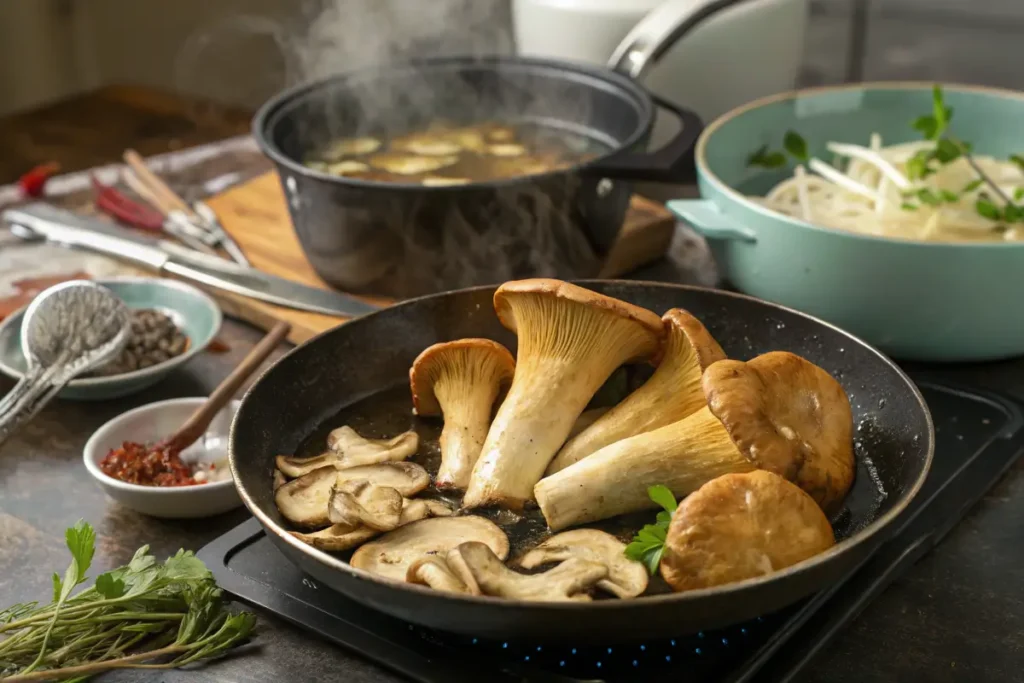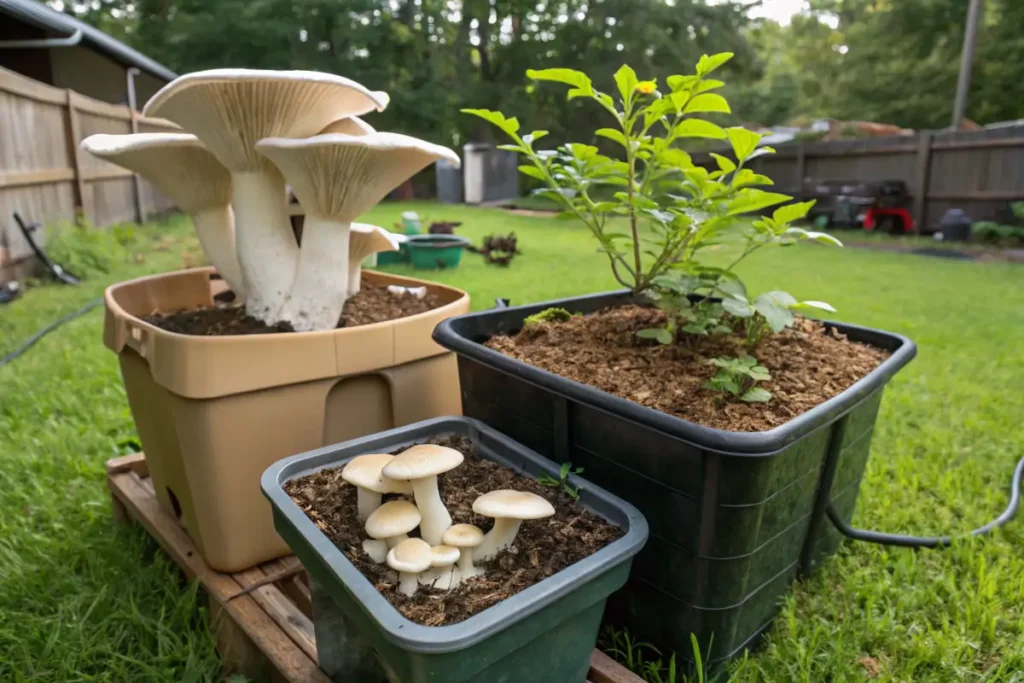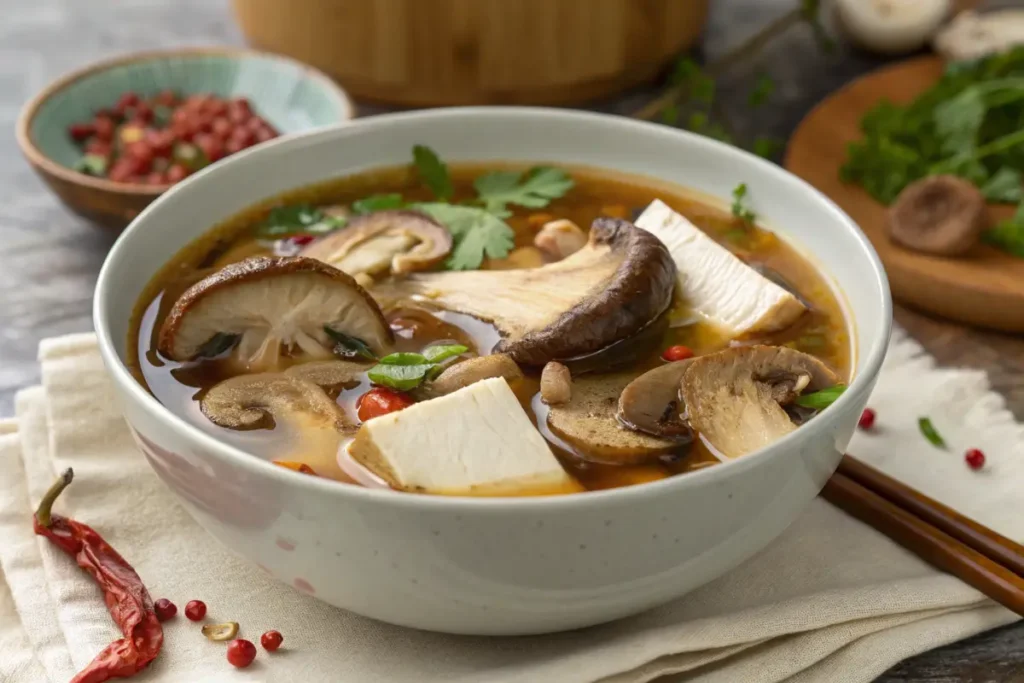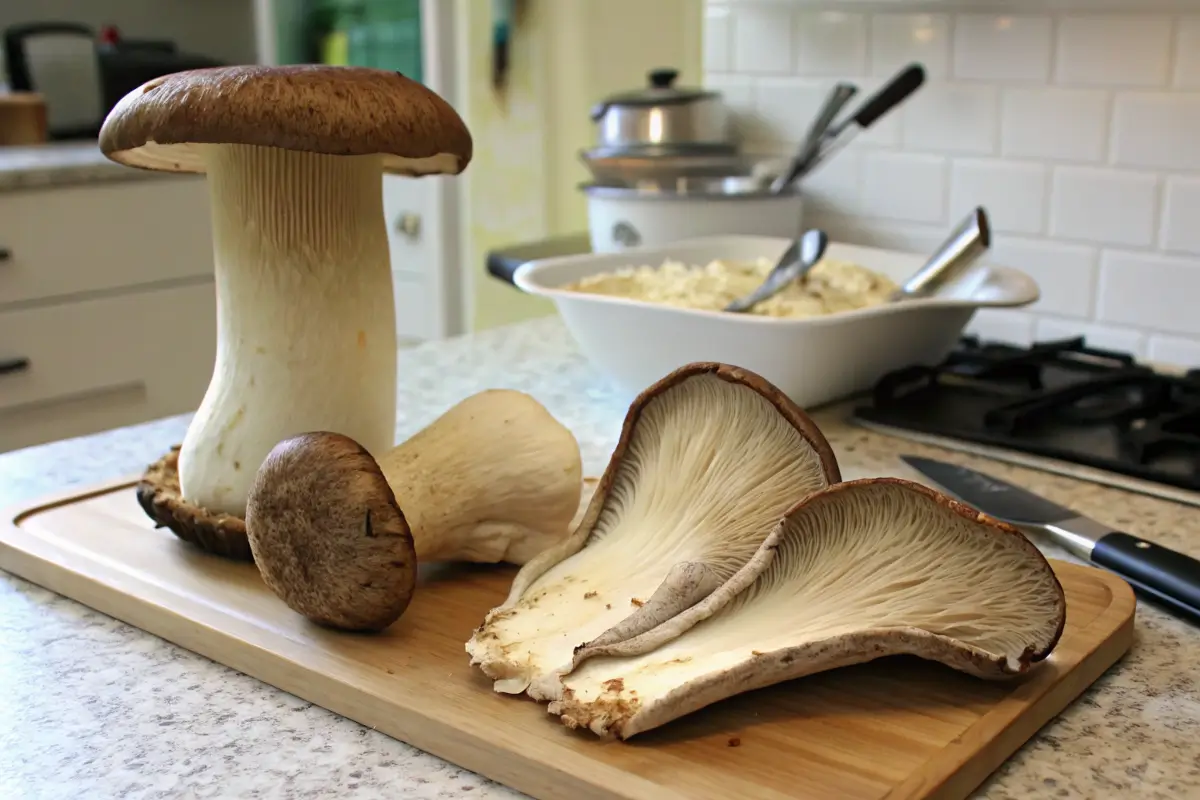Reading time: 11 minutes
Mushrooms are a staple in many cuisines worldwide, but not all varieties are the same. King trumpet mushrooms and oyster mushrooms are two popular edible fungi, often confused due to their similar names. But are they really the same?
In this article, we’ll compare king trumpet vs. oyster mushrooms, exploring their differences, nutrition, cooking uses, and more. Whether you’re a chef, a food enthusiast, or just curious about mushrooms, this guide will help you understand which one suits your needs best.
Let’s dive in!
Table of contents
- King Trumpet Mushrooms: Key Characteristics
- Oyster Mushrooms: Key Characteristics
- Is King Trumpet the Same as Oyster Mushroom?Cooking Difference
- Nutritional Comparison
- Flavor Profiles: Tasting the Difference Between King Trumpet and Oyster Mushroom
- Growing Conditions
- Availability and Seasonality of King Trumpet and Oyster Mushrooms
- Health Benefits
- Popular Recipes Featuring King Trumpet Mushrooms
- Popular Recipes Featuring Oyster Mushrooms
- Substituting King Trumpet for Oyster Mushrooms in Recipes
- Market Names: Various Names for King Trumpet and Oyster Mushrooms
- Expert Tips on Selecting and Storing King Trumpet and Oyster Mushrooms
- Conclusion
- FAQs
King Trumpet Mushrooms: Key Characteristics
King trumpet mushrooms, also known as Pleurotus eryngii or king oyster mushrooms, are unique for their thick, meaty stems and small, flat caps. These mushrooms are often referred to as “trumpets” because of their distinctive shape.
- Appearance: Their creamy-white stems and light brown caps make them easily recognizable.
- Texture: King trumpets have a dense, firm texture, which makes them ideal for grilling or roasting.
- Flavor: These mushrooms are mildly earthy and nutty, often likened to seafood when cooked.
King trumpets are commonly cultivated and widely available in markets, making them a staple for chefs and home cooks alike.
Oyster Mushrooms: Key Characteristics
Oyster mushrooms (Pleurotus ostreatus) are another popular variety, loved for their delicate texture and mild taste. These mushrooms grow in a fan-like shape and come in various colors, such as gray, white, and even yellow.
- Appearance: They have thin, wide caps that resemble oyster shells, hence their name.
- Texture: Unlike king trumpets, oyster mushrooms are tender and less dense.
- Flavor: Their mild, slightly sweet flavor complements a variety of dishes, from stir-fries to soups.
Oyster mushrooms are often found in clusters, adding a visual appeal to any meal.
Is King Trumpet the Same as Oyster Mushroom?Cooking Difference
Both mushrooms shine in the kitchen but serve different culinary purposes. So, is king trumpet the same as oyster mushroom when it comes to cooking? Not quite.
- King Trumpet: These mushrooms are perfect for grilling, roasting, or slicing into thick “steaks.” Their hearty texture mimics meat, making them a vegetarian favorite.
- Oyster Mushrooms: These are best sautéed, stir-fried, or added to soups for a quick burst of flavor. Their delicate texture cooks quickly, which is ideal for fast meals.
Whether you’re looking for a robust base or a subtle garnish, both mushrooms bring something special to the table.
For detailed cooking comparisons, you can check out this article about pickled sausage to understand how food pairings and textures are also crucial in achieving the best dish.

Nutritional Comparison
When considering their nutritional profiles, king trumpet and oyster mushrooms each offer unique health benefits. Both are nutrient-dense options, but their contributions to your diet differ. Here’s a closer look:
King Trumpet Mushrooms:
- Antioxidant-Rich: King trumpet mushrooms are loaded with antioxidants, which help reduce oxidative stress and may lower the risk of chronic diseases.
- Heart Health Support: These mushrooms contain compounds that are believed to promote cardiovascular health by reducing cholesterol levels and supporting healthy blood vessels.
- High in Protein and Fiber: They provide a significant amount of plant-based protein, making them ideal for vegetarians and vegans. The fiber content aids in digestion and promotes gut health.
- Essential Vitamins: Rich in vitamin B6 and niacin, king trumpets support energy metabolism, brain function, and overall vitality.
Oyster Mushrooms:
- Low-Calorie Superfood: Oyster mushrooms are an excellent choice for those watching their calorie intake, as they are low in calories but highly nutritious.
- Vitamin D Powerhouse: Known for their high vitamin D content, these mushrooms help support strong bones and a healthy immune system.
- Rich in Iron: They are a good plant-based source of iron, which is crucial for red blood cell production and preventing anemia.
- Potassium Boost: Potassium in oyster mushrooms helps maintain healthy blood pressure levels and supports muscle function.
Why Both Are Great for Your Diet:
- Light and Wholesome: Both mushrooms are naturally low in fat and calories, making them excellent additions to a balanced diet.
- Versatile Nutrition: Whether you choose king trumpet or oyster mushrooms, you’re adding a wealth of vitamins, minerals, and plant-based nutrients to your meals.
- Health-Promoting Properties: The combination of antioxidants, fiber, and essential nutrients makes these mushrooms a powerful tool for supporting overall wellness.
Incorporating either type of mushroom into your meals allows you to enjoy their distinct nutritional benefits while keeping your dishes flavorful and nutritious.
Flavor Profiles: Tasting the Difference Between King Trumpet and Oyster Mushroom
The taste of a mushroom can define the entire dish. So, how do these two varieties compare?
- King Trumpet: Their mild, umami-rich flavor makes them ideal for savory dishes. They absorb marinades well, enhancing their natural earthiness.
- Oyster Mushrooms: With a hint of sweetness and a softer texture, these mushrooms pair wonderfully with lighter, herbaceous flavors.
Each mushroom has its own personality, catering to different culinary preferences.
Growing Conditions
Understanding how king trumpet mushrooms and oyster mushrooms are grown not only reveals insights into their availability but also their distinctive characteristics. Each type has specific growing requirements that influence their texture, flavor, and where they can be found. Here’s a closer look at the cultivation process for both:
King Trumpet Mushrooms:
- Controlled Environment: King trumpet mushrooms thrive in carefully monitored conditions, usually in indoor, climate-controlled environments. This helps ensure optimal growth.
- Preferred Substrates: These mushrooms are typically grown on substrates like sawdust, wood chips, and grains. The choice of substrate plays a key role in the texture and flavor of the mushrooms.
- Temperature and Moisture Sensitivity: To grow properly, king trumpet mushrooms require a consistent temperature range and high humidity levels. Without these factors, they may not grow as successfully.
- Longer Cultivation Period: Due to the controlled nature of their growth, king trumpet mushrooms often take longer to cultivate than other varieties, but they yield large, meaty mushrooms that are prized for their texture.
Oyster Mushrooms:
- Versatile Growth: Oyster mushrooms are much more flexible in terms of growing conditions. They can grow on a wide range of substrates, including straw, sawdust, and even coffee grounds.
- Innovative Growing Methods: These mushrooms are often cultivated in hanging bags, plastic containers, or logs, making them suitable for various growing setups—both indoors and outdoors.
- Faster Cultivation: Oyster mushrooms typically grow faster than king trumpet mushrooms, often taking only a few weeks to reach harvestable size.
- Adaptable to Different Environments: They can thrive in a variety of climates, making them easier to cultivate in different regions.
Why Both Are Accessible for Growers:
- Ease of Cultivation: Both types of mushrooms are relatively simple to grow, with clear guidelines for home growers and commercial farmers alike.
- Minimal Equipment: While king trumpet mushrooms require more controlled environments, both mushrooms can be grown with basic tools and setup.
- Popular Among Enthusiasts: Due to their ease of cultivation, both king trumpet and oyster mushrooms are popular among mushroom enthusiasts, whether they are cultivating for personal use or business.
The adaptability and relatively simple cultivation processes of these mushrooms make them accessible to a wide range of growers, contributing to their availability in stores and markets year-round.

Availability and Seasonality of King Trumpet and Oyster Mushrooms
The availability and seasonality of king trumpet and oyster mushrooms can influence when and where you’ll find them. While both varieties are cultivated year-round, their natural growth cycles differ.
- King Trumpet Mushrooms: These mushrooms are primarily cultivated in controlled environments, ensuring year-round availability. They’re widely distributed in grocery stores and specialty markets, making them easy to find regardless of the season.
- Oyster Mushrooms: While also cultivated year-round, oyster mushrooms naturally grow in cooler, damp conditions, often thriving in the wild during spring and fall.
Both mushrooms are staples in supermarkets, but visiting farmers’ markets might offer fresher, locally grown options.
Health Benefits
Both mushrooms pack a punch when it comes to health benefits, but they shine in slightly different ways.
- King Trumpet Mushrooms: Known for their high antioxidant content, these mushrooms may support heart health and boost the immune system. They’re also an excellent source of fiber, which promotes digestive health.
- Oyster Mushrooms: These mushrooms are praised for their anti-inflammatory properties and rich vitamin D content, which supports bone health. They also contain beta-glucans, compounds known for strengthening the immune system.
Including either mushroom in your diet can improve overall wellness while adding delicious variety to meals.
Popular Recipes Featuring King Trumpet Mushrooms
King trumpet mushrooms are a versatile ingredient, lending themselves to hearty and flavorful dishes. Here are some popular ways to enjoy them:
- Grilled King Trumpet Mushrooms: Sliced lengthwise and grilled until tender, these make an excellent meat substitute.
- Stuffed Mushrooms: Hollowed-out stems filled with cheese and breadcrumbs make a crowd-pleasing appetizer.
- Mushroom “Scallops”: Thickly sliced stems seared with garlic and butter mimic the taste and texture of scallops.
Their firm texture and umami flavor make them a favorite for vegetarian and non-vegetarian dishes alike.
Popular Recipes Featuring Oyster Mushrooms
Oyster mushrooms are delicate and quick to cook, making them perfect for a variety of dishes. Some popular recipes include:
- Stir-Fried Oyster Mushrooms: Sautéed with garlic, soy sauce, and a touch of sesame oil, they’re a quick and flavorful addition to rice or noodles.
- Creamy Mushroom Soup: Their mild flavor blends well into creamy soups, offering richness and depth.
- Mushroom Tacos: Lightly seasoned and pan-fried, these mushrooms create a delicious filling for vegetarian tacos.
Their versatility allows them to fit seamlessly into many cuisines and recipes.
Substituting King Trumpet for Oyster Mushrooms in Recipes
When you’re out of one type of mushroom, knowing how to substitute it with another can be a lifesaver. So, is king trumpet the same as oyster mushroom when used interchangeably? Not exactly, but with a few minor adjustments, they can both work well in a variety of dishes. Here’s how they compare and how you can swap them out in different cooking scenarios:
Soups and Stews:
- King Trumpet Mushrooms: These mushrooms are firmer and hold their shape better, making them a great choice for soups and stews that require longer cooking times. They retain their texture even after simmering for extended periods.
- Oyster Mushrooms: While delicious, oyster mushrooms tend to become softer and may break down more during long cooking.
- Substitution Tip: If you’re using oyster mushrooms in a stew or soup but only have king trumpets on hand, slice the king trumpets into larger pieces to maintain their firmness throughout the cooking process.
Stir-Fries:
- Oyster Mushrooms: Oyster mushrooms are quick-cooking and tender, making them a fantastic option for stir-fries where ingredients are cooked at high heat for a short time.
- King Trumpet Mushrooms: These mushrooms take a bit longer to cook and are denser, so they need more time to soften when stir-fried.
- Substitution Tip: Thinly slice king trumpet mushrooms to match the cook time of oyster mushrooms. They will absorb flavors quickly and work well in stir-fries, though you may need to cook them for a slightly longer time.
Grilled Dishes:
- King Trumpet Mushrooms: Thanks to their firm, meaty texture, king trumpet mushrooms are perfect for grilling. They hold up well over direct heat and maintain their structure, giving a satisfying bite.
- Oyster Mushrooms: These mushrooms are more delicate and can become too soft when grilled, making them less ideal for this cooking method.
- Substitution Tip: If you don’t have oyster mushrooms for grilling, king trumpets are your best bet. Their thicker texture and sturdy structure make them ideal for grilling whole or in large pieces.

Market Names: Various Names for King Trumpet and Oyster Mushrooms
Both mushrooms go by different names depending on the region, which can sometimes cause confusion.
- King Trumpet Mushrooms: Also known as king oyster mushrooms, French horn mushrooms, and trumpet royale.
- Oyster Mushrooms: Referred to as pearl mushrooms, tree mushrooms, and hiratake in Japanese cuisine.
Knowing these names can help you identify and purchase the right mushrooms when shopping locally or internationally.
Expert Tips on Selecting and Storing King Trumpet and Oyster Mushrooms
Proper selection and storage are key to keeping your mushrooms fresh and flavorful.
- Selecting King Trumpet Mushrooms: Look for firm, unblemished stems with smooth caps.
- Selecting Oyster Mushrooms: Choose clusters with bright, intact caps and avoid any with slimy textures.
- Storing: Keep both types in a paper bag in the refrigerator to prevent excess moisture. Use within 5-7 days for the best flavor and texture.
Following these tips ensures you get the most out of your mushrooms.
Conclusion
While king trumpet mushrooms and oyster mushrooms come from the same fungal family, they have distinct differences in appearance, texture, flavor, and culinary uses.
- King trumpet mushrooms are thicker, meatier, and denser, making them ideal for grilling, roasting, and meat substitutes.
- Oyster mushrooms are softer, more delicate, and absorb flavors well, making them perfect for stir-fries, soups, and sautés.
- Both mushrooms are highly nutritious, offering fiber, antioxidants, and immune-boosting benefits.
Ultimately, which one is best depends on the recipe and your cooking preferences. Whether you’re making a hearty plant-based dish or a quick stir-fry, both mushrooms bring incredible flavor and texture to your meals!
FAQs
Yes, you can eat the whole King Trumpet mushroom, including the cap and stem. Both parts have a firm texture and a rich, umami flavor, making them great for various cooking methods like grilling, roasting, or sautéing. Learn more about this subject in this post.
Yes, King Oyster Mushrooms (also called King Mushrooms) are edible and highly prized for their meaty texture and umami flavor.
The best oyster mushroom depends on your cooking needs:
Pearl oysters – Mild and versatile.
King oysters – Thick and meaty.
Golden, pink, or blue oysters – Unique flavors and colors for creative dishes.
You can explore more recipes from here:

